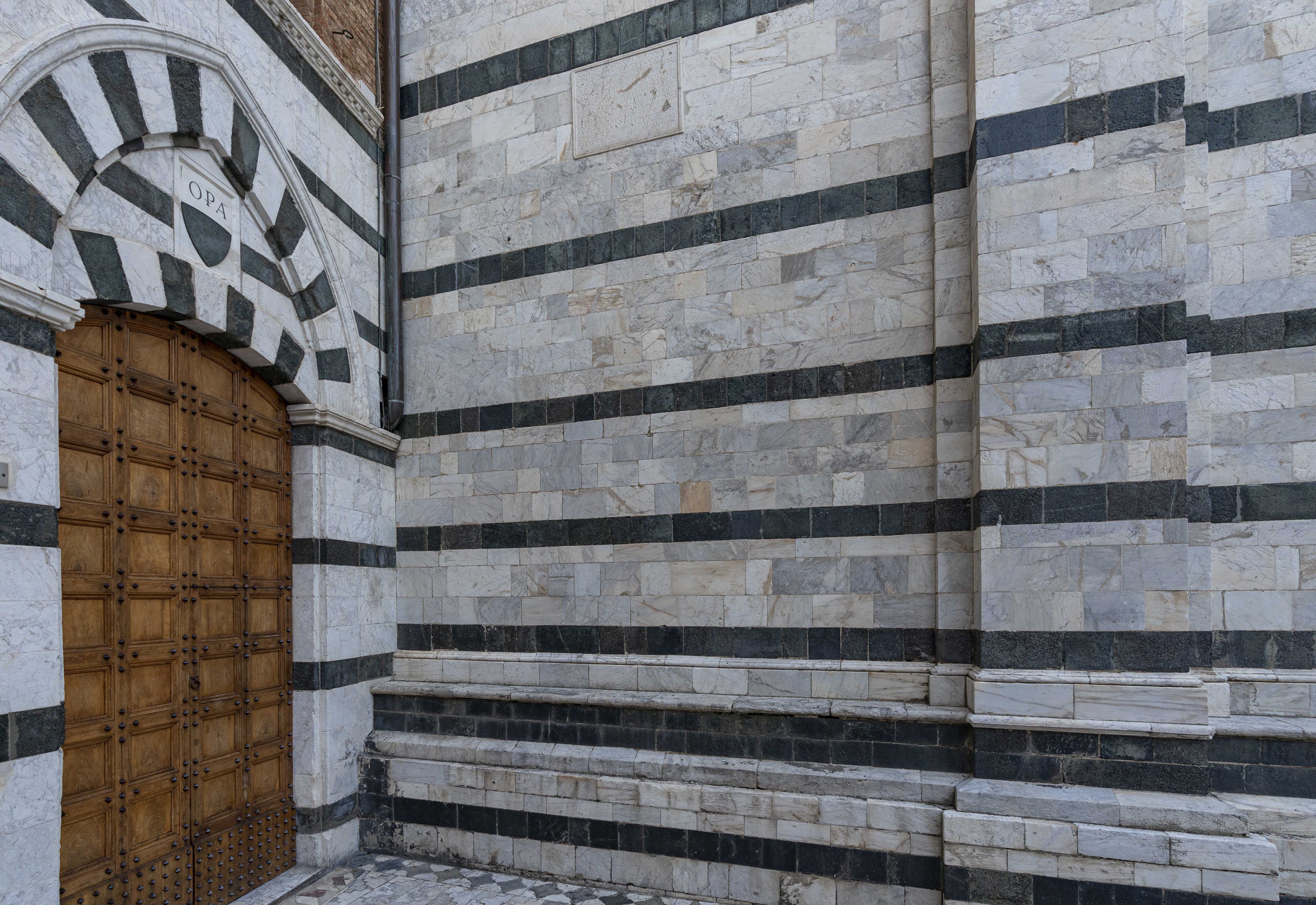2.7 Science, art, mystery
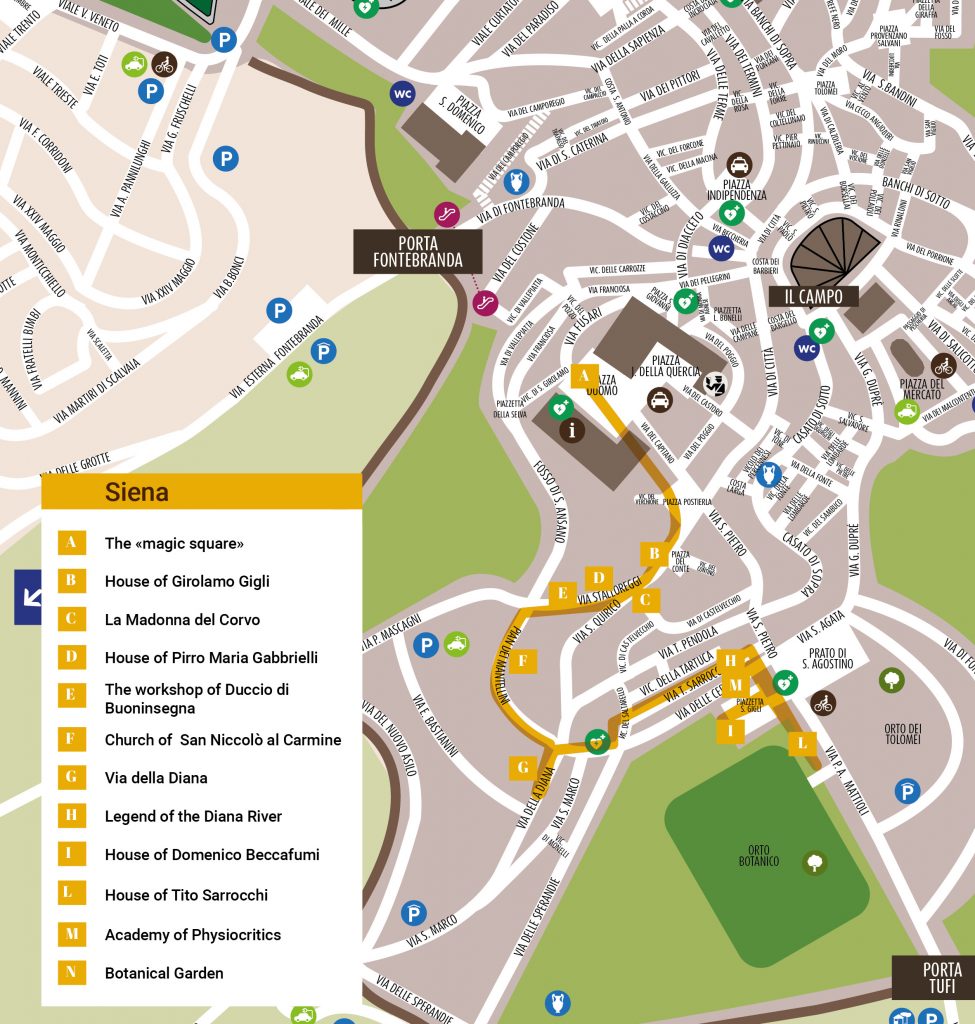
The “magic square”
We are in piazza del Duomo. We will have already admired the Cathedral, the ancient Santa Maria della Scala, the Metropolitan Opera Museum. And hence we can devote ourselves to a curiosity hidden among the stones on the left side of the Cathedral, next to a secondary entrance of the archbishop’s palace marked by number 7. It is the so-called Magic Square , also known as “the Sator palindrome”. A square formed by five words, one below the other, each composed of five letters that can be read from left to right and vice versa, from top to bottom and in the opposite direction, where the word of the third line remains identical even in its reverse side. If then the five words were written one after the other, the phrase that is formed would remain the same even if read backwards. Hence a palindrome. 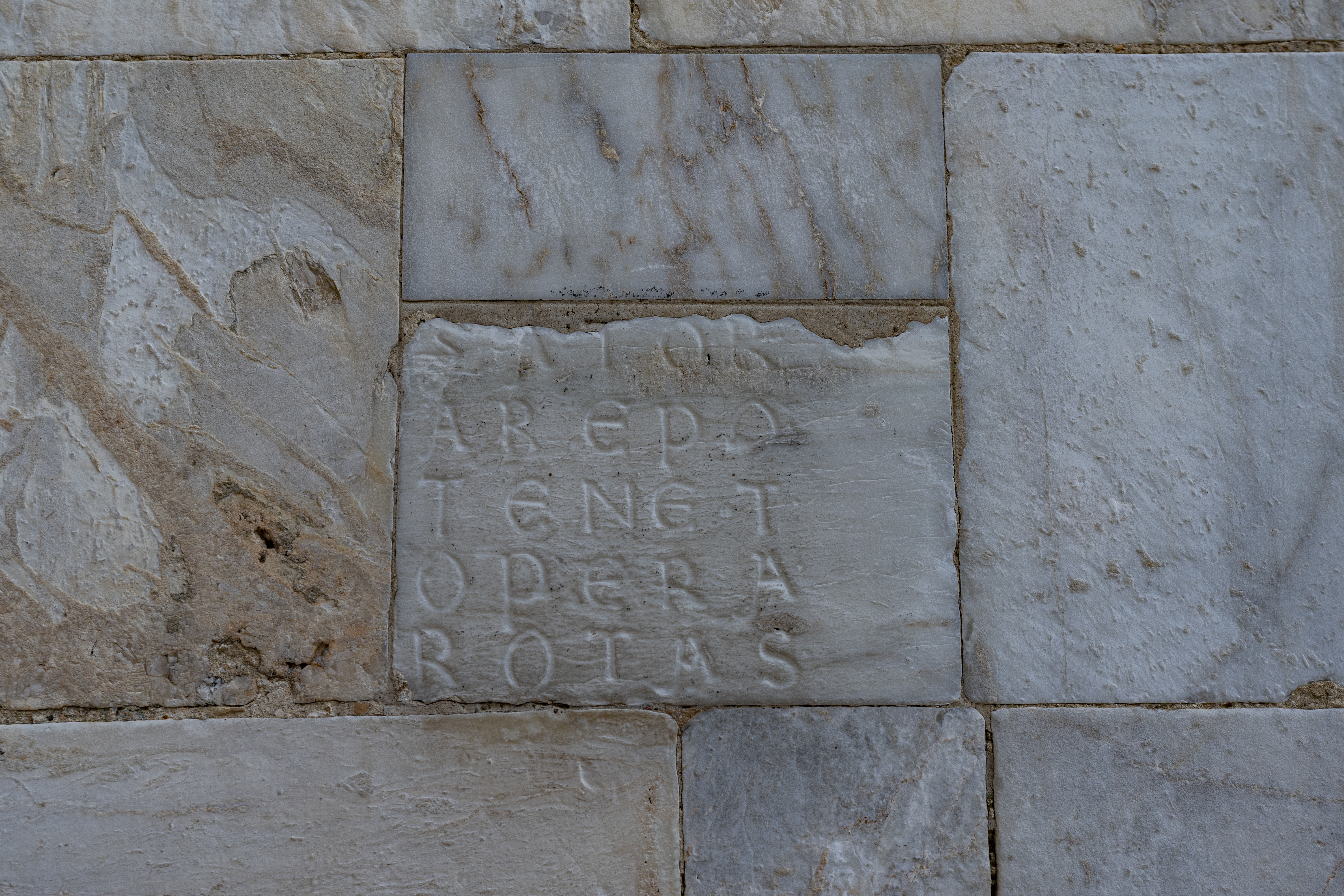
S A T O R A R E P O T E N E T O P E R A R O T A S
The ingenious quadrilateral, just as we know, is not only traceable among the stones of the Sienese Cathedral. We find it among the remains of Pompeii, in Rome in the basement of the Santa Maria Maggiore Basilic, in the Abbey of Montecassino, in some castles of France, at san Giacomo di Compostela; it was found on a brick during the excavations of Aquincum (now Budapest), and again on Coptic and Ethiopian papyri and amulets. Until almost the entire nineteenth century a medieval invention had been thought of, since all known sources were not prior to the sixth century, until 1868 in England, while archaeologists were digging among the Roman ruins of Cirencester (the ancient Corinium) those words emerged from the plasters of a house datable between the second and fourth centuries AD. It was thought, then, that it could be a cruces concealed and, a way for the early Christians to assert their beliefs. In the early decades of the twentieth century, the idea was greatly appreciated by a learned Evangelical pastor, Felix Grosser, who argued that the twenty-five letters arranged in a certain way formed the words PATERNOSTER. The incipit of the ancient prayer was thus crossed between a A and a O, which in the Greek alphabet stand for alpha and omega and that in Christian symbolism mean the principle and the end of all things in God:
A
P
A
T
E
R
A PATERNOSTER O
O
S
T
E
R
O
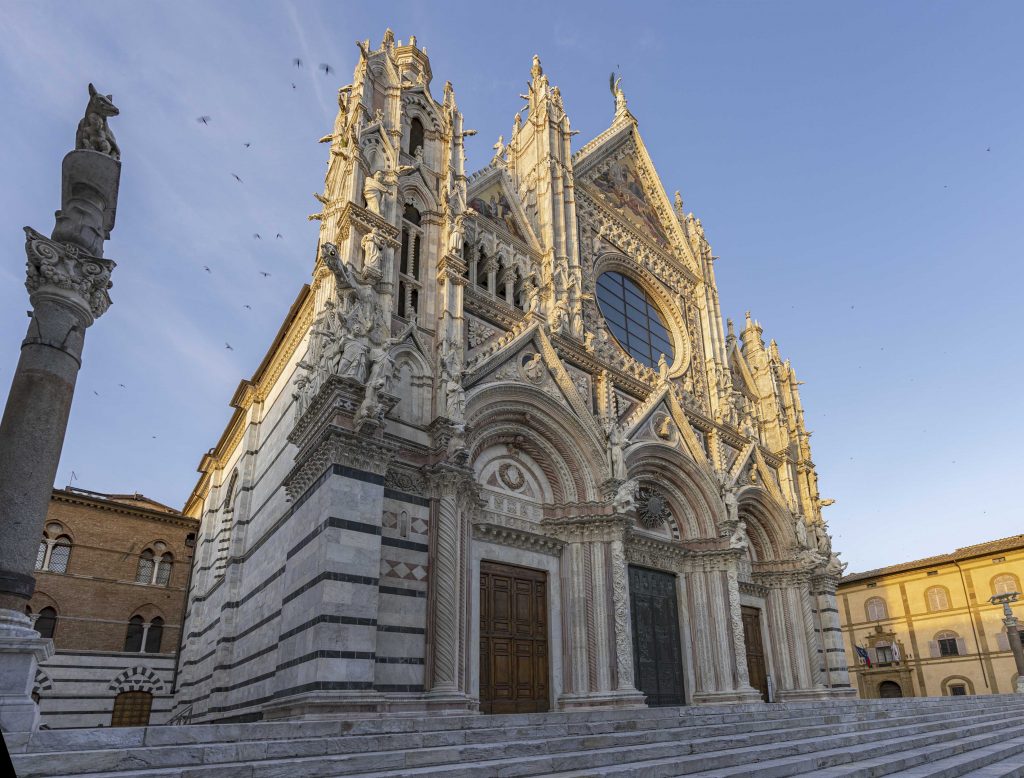
Moreover – Grosser noted again – the two words TENET form a cross and have at their extremities the T, that is, the Greek tau , also a symbol of the cross of Christians. An answer was also found for the use of the word AREPO, which does not exist in Latin, discovering that at the time of the Roman domination in Gaul, the measure of semiugerum surface was also called arepennis, named after a wagon used for ploughing the fields. Therefore Celtic arepos may have turned for Latins to arepus. The suppositions aroused further enthusiasm when in the middle of the pages of a 14th century Greek Bible appeared a translation of the mysterious square in which the word AREPO corresponded to the Greek plough (chariot). Therefore, the phrase was deducted: «The Sower, with his chariot, carefully keeps the wheels» What rendered the evangelical shepherd’s conjectures dubious, however, was a discovery during the excavations of Pompeii in 1936, when an intact copy of the inscription was read in the groove of a column in the Great Gymnasium, next to the Amphitheatre. At that point interpretation in a theological sense began to fluctuate, since from the ashes of Pompeii no traces of Christian worship emerged and, moreover, the alpha and the omega are symbolically recalled by the evangelist John in a text that could only be known in the South of Italy after 120-150. However, certain researchers, such as Jérôme Carcopino, did not give up, putting forward the hypothesis that the much debated graffito could have been engraved by excavators after the date of the eruption. The archaeologists’ further replica challenged the thesis: the layers of sediment found above the inscription were intact. There were some medieval beliefs that the Sator had healing powers for canine hydrophobia. Magical virtues were also attributed to it by Renaissance alchemists who recommended its use as a talisman. While more disturbing conclusions were reached by the Jesuit Athanasius Kircher who considered it a symbol of Satan. Luckily, Positivism emerged as more simply a good puzzle game. Well, the centuries-old intrigue is perpetuated even in that suspended time that seems to embrace Siena. Thus, while hisses, wise men, prophets, all the excellent inhabitants of the Cathedral, from their marbles assert faith and truth, the defiant stone of the Sator constantly breaks down and reformulates its own rebus.
Genius and unruliness
We leave the Cathedral Square. Along the via del Capitano you reach Piazza della Postierla and, on the right, via Stalloreggi. At number 34, a plaque indicates that «here lived Girolamo Gigli, satirical poet born in Siena on October 14, 1660, died in Rome on January 4, 1722». Recent research indicates that, for a case of homonymy, the wrong Gigli was resident in this building. We are interested in the character anyway, and we must say that, in any case, the synthetic tombstone does not render him the due credit. Although it is true that Gigli, a cultured, moody and funny man, would not be easy to confine him to celebratory epigraphs. He was born part of the Nenci family, but, adopted by a great-uncle, he took his surname and inheritance, wasted in record time. He married Laurenzia Perfetti, who was more mature than him, with whom he had twelve children.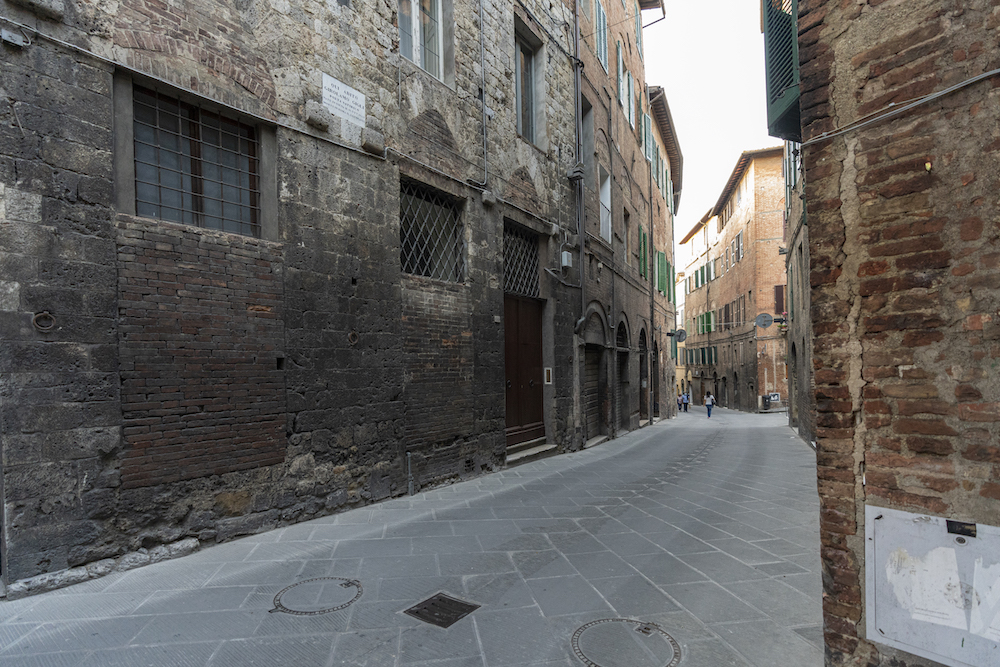 A rather unhappy union, at least judging by the furious quarrels they held on a daily basis. He, a temperamental man, out of the box; she – said her husband – an avaricious and bigoted woman. In 1668 Girolamo Gigli taught at the University of Pavia and later held the chair of Tuscan Literature at the University of Siena. He was among the attendees of the Accademia degli Intronati, where he also held the position of secretary. In the Academy he was called, not without irony, the Economic. The Sienese comedy writer succeeded in bringing certain characters and topics of French comedy into the Tuscan environment, and from these remakesIl don Pilone, ovvero il bacchettone falso, written in 1711 (adaptation of the Tartuffe by Molière) and La sorellina di don Pilone. With the latter – staged at the Teatro dei Rinnovati during the carnival of 1712 and succeeded in uncovering the preventive censorship of the Jesuits – he took some sarcastic revenge on his wife and relatives, ruthlessly pillorying them. The verse opera La Dirindina was musically performed by Alessandro Scarlatti.
A rather unhappy union, at least judging by the furious quarrels they held on a daily basis. He, a temperamental man, out of the box; she – said her husband – an avaricious and bigoted woman. In 1668 Girolamo Gigli taught at the University of Pavia and later held the chair of Tuscan Literature at the University of Siena. He was among the attendees of the Accademia degli Intronati, where he also held the position of secretary. In the Academy he was called, not without irony, the Economic. The Sienese comedy writer succeeded in bringing certain characters and topics of French comedy into the Tuscan environment, and from these remakesIl don Pilone, ovvero il bacchettone falso, written in 1711 (adaptation of the Tartuffe by Molière) and La sorellina di don Pilone. With the latter – staged at the Teatro dei Rinnovati during the carnival of 1712 and succeeded in uncovering the preventive censorship of the Jesuits – he took some sarcastic revenge on his wife and relatives, ruthlessly pillorying them. The verse opera La Dirindina was musically performed by Alessandro Scarlatti.
Girolamo Gigli is rightfully considered a forerunner of the theatrical reform later carried out by Goldoni. The Venetian, in fact, acting as a very young La sorellina di don Pilone and going later to Tuscany to study the “living texts”, he was convinced that it would be necessary to transform the comic theatre based on the “entirely written” comedy. Gigli’s fame reached Vienna where he was invited as Charles VI’s caesarean poet, , but the Sienese man declined the invitation to continue having fun in the microcosm of his city, producing the best of his genius and unruliness. To those who advised him to behave more in line with the social and cultural traditions of the time, he responded: «Then you want me dead! I can’t live if I don’t live insanely». For history scholars it is a very rich source of information the Diario Senese, is a very valuable source of information, two volumes in which Gigli collected «distinguished sacred and profane things that illustrate the annals of Siena», from which it is possible to obtain information on events, customs and institutions related to the centuries before Gigli himself. No less important was the publication (in 1717) of all the writings of St. Catherine of Siena, which was accompanied by the Caterinian Vocabulary, Caterinian Vocabulary, a lively and facetious ‘linguaiola’ collection that caused a stir among the Jesuits and academics of the Crusca, since the former saw it as a sort of mass ridicule of the saint, and the latter concluded that this work was intended to question the superiority of the Florentine language over the Sienese one. Such was the fury against Jerome that Cosimo III issued a provision forbidding the reading of the Vocabulary. But something else came to light: on September 9, 1717, Gigli’s work was publicly burned by the executioner in Piazza Sant’Apollinare in Florence. As if that was not enough, Jerome was removed from the Order of the Crusca and the Order of professors. They wanted him to deny his work, but the stubborn professor told them that he would never do it, even if he was threatened with being thrown from a tower, because the Sienese idiom was too superior to the Florentine one. The Grand Duke of Tuscany exiled him. In 2008, after almost three centuries, the Accademia della Crusca published an anastatic copy of the Caterinian Vocabulary that had so infuriated the members of the Crusca.
Along the ancient road
Still on the ancient street of Stalloreggi, corner with street of Castelvecchio, on the facade of a house one will notice the large tabernacle enclosing the Pietà (early decades of the sixteenth century) frescoed by Sodom and popularly called Madonna del Corvo. 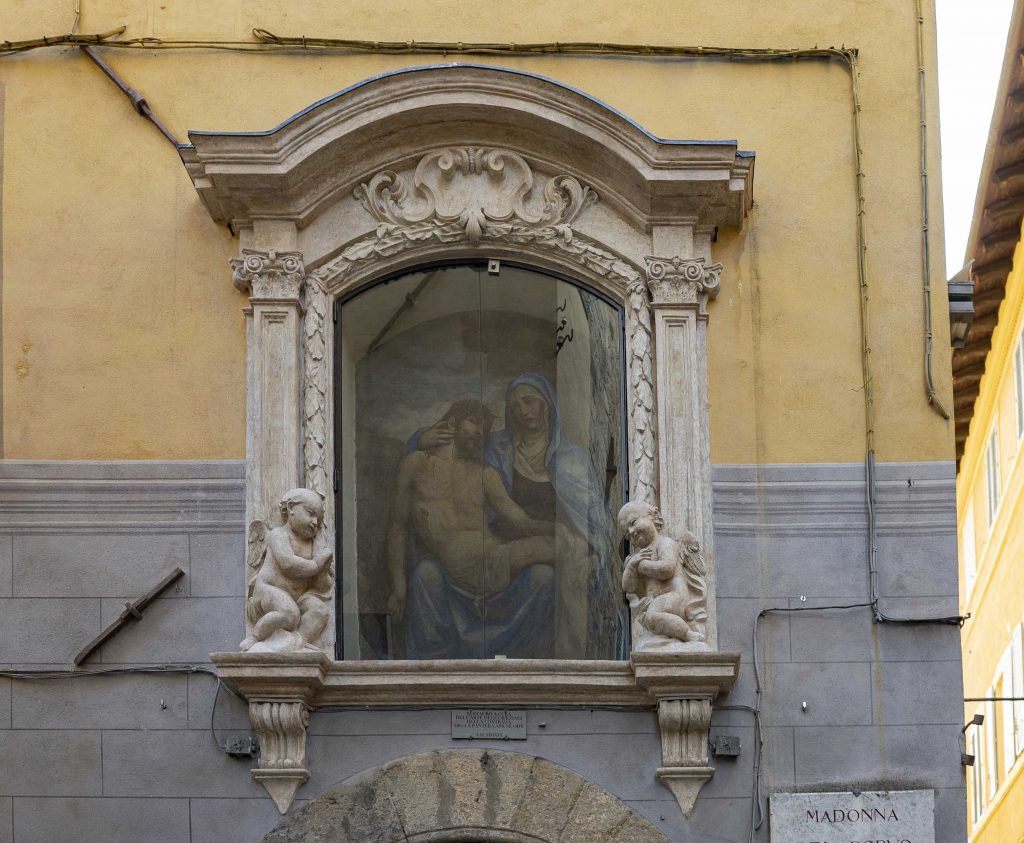 Appellative likely due to the representation of an eagle (which could also look like a raven) placed, in the seventeenth century, on the facade of the palace that belonged to the Marescotti family, whose family emblem was, in fact, the eagle. Just like the possibility cannot be ruled out that Sodom – accustomed to this kind of oddities – had really painted a raven on it. But the version that has been handed down is the legendary one, offered in at least two variants. The story says that, in 1348, a raven suffering from the plague fell dead in this part of the street, spreading the epidemic in the city. Or if you prefer: the raven flew over the tabernacle, was electrocuted, fell to the ground, but Siena was saved from the tragic contagion. From the legend we move on to stories of more secular stories. At number 61 lived the scientist Pyrrhic Maria Gabbrielli (1643-1705) whose name is linked to the establishment of the Academy of Physiocritics (we will come to the end of our itinerary). After completing his studies in Philosophy and Medicine, Gabbrielli devoted himself to university teaching and research. His scientific activity was distinguished by a strong experimentalist spirit that he applied in different fields, ranging from anatomy to botany, from chemistry to mineralogy. On the medical aspect, he studied and tested new drugs using chemistry and, therefore, indicating an overcoming of galenism, to the point that he promoted a reform of the Sienese apothecary’s shop. The prestige achieved even across the border, put him in touch with the major specialists of the time. Precisely because of his experimentalist fervor he was blamed for being too adherent to the opinions of the modern world.
Appellative likely due to the representation of an eagle (which could also look like a raven) placed, in the seventeenth century, on the facade of the palace that belonged to the Marescotti family, whose family emblem was, in fact, the eagle. Just like the possibility cannot be ruled out that Sodom – accustomed to this kind of oddities – had really painted a raven on it. But the version that has been handed down is the legendary one, offered in at least two variants. The story says that, in 1348, a raven suffering from the plague fell dead in this part of the street, spreading the epidemic in the city. Or if you prefer: the raven flew over the tabernacle, was electrocuted, fell to the ground, but Siena was saved from the tragic contagion. From the legend we move on to stories of more secular stories. At number 61 lived the scientist Pyrrhic Maria Gabbrielli (1643-1705) whose name is linked to the establishment of the Academy of Physiocritics (we will come to the end of our itinerary). After completing his studies in Philosophy and Medicine, Gabbrielli devoted himself to university teaching and research. His scientific activity was distinguished by a strong experimentalist spirit that he applied in different fields, ranging from anatomy to botany, from chemistry to mineralogy. On the medical aspect, he studied and tested new drugs using chemistry and, therefore, indicating an overcoming of galenism, to the point that he promoted a reform of the Sienese apothecary’s shop. The prestige achieved even across the border, put him in touch with the major specialists of the time. Precisely because of his experimentalist fervor he was blamed for being too adherent to the opinions of the modern world.
The most beautiful table you could ever see
After having walked all along via di Stalloreggi, almost close to the arch indicating one of the gates of the circle of walls built in the year 1000, we find (at number 93) the building where Duccio di Buoninsegna (1255 around- 1318/19) would have kept workshop and built the famous Maestà, a large board (4.25 x 2.12 meters) painted on two faces, to be placed «on the high altar of the main church of Santa Maria di Siena» (today it is exhibited in a room of the Museo dell’Opera del Duomo). Considered a masterpiece of the Italian fourteenth-century art, Duccio spent almost three years to complete it (1308-1311), but even before it was finished, the work was widely regarded as an exceptional work. He worked there without interruption for thirty-two months, since Jacopo del fu Gilberto de’ Marescotti, administrator of the Opera del Duomo, committed him to painting the imposing altarpiece «as best he could and he knew the Lord would bless him», without interruption or distraction in other works. All this for 16 money of Siena money per day. Not few money. Thus, before the notary Paganello di Diotifece, the Good Teacher vowed fidelity to the covenants by placing his hand on the Gospels (corporaliter tacto libro). It was October 1308, and on June 9, 1311, with a great feast of the people, from Duccio’s workshop la Maestà was taken in procession to the Cathedral. A reporter at the time wrote: «And on the day that [la Maestà] was brought to the cathedral, all the workshops remained closed and the Bishop led a long line of priests and monks in solemn procession. They were accompanied by officers of the municipality and all the people; all the important citizens of Siena encircled the altarpiece with candles in their hands, and the women and children humbly followed them. They accompanied the altarpiece among the sounds of the bells through the Piazza del Campo to the interior of the cathedral with deep respect for the precious altarpiece. The poor people received many alms and we prayed to the Holy Mother of God, our patroness, so that in her infinite mercy she would preserve our city of Siena from misfortune, traitors and enemies». The festivities continued with sounds, fireworks, firecrackers. It’ really amazing to imagine an entire city celebrating a work of art.
The Water Dream
After passing the Arch of two doors, we turn left towards Pian dei Mantellini. A large space that extends along the line once constituted by the walls of the 11th century. On the facade of the Palazzo Sergardi, at number 28, is recognizable the pre-existing church of St. Orsola or the Derelicts (about 1554). At number 40 is the neoclassical Palazzo Incontri (1799-1804), while, among the numbers 39-41, stands the elegant Palazzo Celsi-Pollini, the work of Baldassarre Peruzzi, characterized by a scarp base and a richly decorated cornice. Opposite is the church of San Niccolò al Carmine. Building of the 14th century, on which, in 1517, interventions were carried out, probably on the design of Peruzzi himself. It was a Carmelite church until a few decades ago, and even the toponym pian dei Mantellini can be traced back to the presence of the Carmelite friars, who wear a small cloak on their robes. Inside are kept valuable works of art. These included the 14th-century Madonna dei Mantellini, an object of popular devotion. It seems that it was called of the capes not only for the reasons already mentioned related to the dress of the Carmelites, but also for the skirts or capes that the children gave her for the grace received. The Carmelite monks of Pian dei Mantellini are also linked to a story that has become a myth: the river Diana (hence the name Via della Diana given to the road that runs alongside the former convent on the right). The story begins in 1176, when the monks of the Carmine, determined to provide themselves with a well, dug in their garden, for as much as 80 arms, finding a substantial vein of water suggesting that down there could be a real river that flowed from the upper area of Castelvecchio until it reached, at the bottom of the valley, the torrent Tressa. The news made an understandable impression. If this were the case, the Carmelites would have really discovered holy water, given the water shortage from which the city had always suffered. With the hunger of the gold diggers, they began digging with great effort. Mountains of earth grew from the break-ins. Nothing, however, that would allow the trace of the hypothetical river which, in the meantime, had been given the name Diana, the goddess guardian of the sources and streams. The more it was not there, the more it seemed to be there. How else could they explain the infiltration of damp that penetrated foundations and cellars in the area; and then that noise that sometimes seemed to come from under the ground. It was imperative to insist, then. So in 1295 the City Council voted on a measure to continue to seek the waters of the l’Diana’s river. Resolution approved by a very large majority: 169 yes against the 38 no of the sceptics. At that point the research became a gigantic undertaking. They started digging around, even in really unlikely areas. Outside POrta Camollia the devastating construction site caused the collapse of the church of Vico, attached to a convent of nuns who, understandably irate, demanded compensation of 25 lire from the municipality. And here, between the nuns’ anger and the frustration of the excavators, the public administration resolved to put an end to the inconclusive work. Thus a hope was aborted and a myth was born. In fact, the grandmothers continued for centuries to tell stories of men, curious and fearless, still looking for Diana, who had descended into the well of Carmine to never return. Swallowed by the maelstrom of mystery. The constant search for this “river entity perpetually in silence” (the witty expression is by Cesare Brandi), soon became a widespread and ironic fable. The most cultured mocking bears nothing less than Dante’s signature. The Supreme, in fact, in the Comedy wanted to capture the fate of the Sienese for how they had started to pursue two rambling ambitions related to water: annexing the port of Talamone to the possessions of the Republic and looking for the non-existent Diana river. In Siena, on the other hand, the building of a water supply system, built between the thirteenth and fifteenth centuries through 25 kilometres of tunnels (the so-called booties) in which infiltrations and veins of water could be channelled to feed tanks, springs and washtubs, was not in vain. A masterpiece of architecture and hydraulic engineering. A fascinating underground network of paths, still viable today. This relationship between Siena and water has become, with time, intrinsic to the city itself. Mario Luzi explained it well when he wrote: «Meanwhile the Diana, mythical underground waterway continues to flow in its innermost depths and in the initiatory imagination of the Sienese», because – the poet argued – «the water in Siena is moderately visible. It does not play with itself, it does not rejoice or complain as it happens where it has an open scene. And yet in Siena the idea of water is not foreign or aberrant: I was caught wondering if in the courtyard of a famous palace the water of a fountain or the musical conjugation of water stone sang illusively in my memory». That’s right. The water in Siena is phantasmagoric. Escaping in rare apparitions, but persistent in the imagination. As when the Marquis De Sade, while observing Piazza del Campo, wondered if the square had the shape of a shell «to be filled with water during naumachia shows». After all, this idea of a city full of waves often occurs in the imagination of writers. To the point that the most recurrent comparison is that of “a Venice without water”: Charles Dickens notes this in his travel notebook, Giovani Comisso reaffirms it. While Diego Valeri, from Veneto as he was, specifies: «For those who live their daily life in Venice, Siena is not only the splendid wonder of Siena, but also a perfect synthesis “of the other world”, that is, the world of the earth. Venice is “in water without walls” (as Franco Sacchetti said); Siena is “in walls” without water». Know, therefore, that in Siena the water (or its dream) is there even when you don’t see it.
They called him Mecherino
Pian dei Mantellini ends at the Arco di Santa Lucia, through which you access the road named after the sculptor Tito Sarrocchi (1824-1900). Until 1933, the street was called via dei Maestri. And indeed, it had seen some masters. Among which, as recalled in the plaque at number 35, Domenico Beccafumi (1486-1551). Domenico di Jacopo di Pace, commonly known as Beccafumi or more pleasantly Mecherino, was a prominent personality of the so-called Mannerism, and perhaps the last influential artist of the Sienese school. Son of farmers, he was born in the countryside of Monteaperti (that of the famous battle). Not even in his thirties and he already enjoy a considerable reputation and, consequently, a certain well-being. He invested his earnings in the purchase of houses, including two in this street, where he lived permanently (it is not excluded that Beccafumi designed the facade himself). It is known, however, that he preferred to work at home. Famous is the episode when the Opera del Duomo di Pisa demanded that the artist move to the shores of the Arno to create some artworks Among these a Madonna and saints, which was then lost in a fire. According to Vasari it was not a great loss. It was, according to him, a rather mediocre work. The author himself was ready to admit it, who justified himself to his friend Vasari, arguing that «outside the air of Siena he didn’t seem to know how to do anything». Undoubtedly in Siena he worked very well. He was responsible for numerous paintings, important frescoes in the Santa Maria della Scala hospital, some cartoons for the inlays on the floor of the Cathedral. Beccafumi had, therefore, celebrity and wealth, even though five years before he died he declared to the land registry that «I am old» with «my wife, 3 daughters and a dungeon son». He asked for understanding “to your lordships” for the fact that the only male heir he had since the first marriage was a reckless waster The boy, named Adriano, worked as an apprentice at a delicatessen, but also carried out the activity of “whistler”, that is to say as a bird caller on hunting trips. In his own way an artist too. The plaque placed on the building at number 3 indicates, instead, the house where Tito Sarrocchi was born. He was a young apprentice in the restoration works of the Siena Cathedral. He worked in Florence in important sculpture workshops. It was appreciated mainly for the reproductions of ancient sculptures that replaced the removed originals to preserve them from the wear and tear caused by time. Among these, the marble of Fonte Gaia, in Piazza del Campo, sculpted by Jacopo della Quercia. Sarrocchi made the copies in 1868, the result of a careful study of Jacopo’s style and preceded by the creation of plaster models.
All the truth of Science
Via Tito Sarrocchi leads to Via San Pietro and, on the right, beyond the arch, we find ourselves in the meadow of Sant’Agostino. A little further on, still on the right, widens the Piazzetta Silvio Gigli where theAccademia dei Fisiocritici is located, founded in 1691 at the will of the doctor Pirro Maria Gabbrielli (of which we have already had occasion to speak) and other professors of the University of Siena. An institution born under the sign of the modern scientific debate to search ‘the true’ of natural phenomena through experimental practice: «to scrutinize and investigate with judgement the secrets of nature and almost like judges to reject from the natural sciences what is false in order to better discover what is true». Among his associates he had scientists such as Carlo Linneo, Joseph-Louis Lagrange, Alessandro Volta, Louis Pasteur. Giovanni Paolo Mascagni (1755-1855), a renowned anatomist and professor of Anatomy at the University of Siena, also belonged to the prestigious association – and in 1798 he became its president.
When the French occupied Tuscany, Mascagni openly took sides with the Jacobins, so that he was arrested and imprisoned for seven months. Until, on October 22, 1801, the King of Etruria ended the detention of the scientist with a motu proprio, appointing him professor of anatomy, physiology and chemistry at the University of Pisa and forcing him to give lectures also at the Florentine Hospital of Santa Maria Nuova. What made him famous throughout Europe were his studies on lymphatic vessels and anatomical tables, made in life-size, extremely innovative precisely because, for the first time, he brought back the lymphatic system. The tables are now preserved in the Accademia museum. Since 1816 the Physiocritics occupy the current location, formerly monastero camaldolese della Rosa (the original structure dates back to the XII century). And it is in these premises that one of the oldest and most interesting museums of Natural History of Tuscany is located, with a rich collection of minerals, fossils, zoological and anatomical findings. There are about 3000 bird relics and almost 700 mammals, with specimens from all continents, including many rarities and an extinct species. The Geological Section includes minerals from various countries offering a vast overview of global geodiversity (among the most impressive pieces, a purple amethyst geode with a diameter of over half a meter and a meteorite sample belonging to the meteor shower that fell in 1794 in the Sienese countryside). Immediately at the entrance to the museum a 15 meter long whale skeleton is on display. In the Aula Magna there is a nineteenth-century sundial line that crosses the floor with the line of Middle Time in the shape of eight, the months, the signs of the zodiac. The sundial – now made active by an electronic device that simulates the movement of the sun – was made created the end of 1848 and the beginning of 1849 in memory of the previous physiocritical heliometer created by Gabbrielli in 1704 and destroyed by the 1798 earthquake. Concerning the sundial of the Physiocritics, it is interesting to say that, in the mid-nineteenth century, every Monday morning the watchmakers of Siena came to the Academy to wait for the sun to reach the noon line to record the exact time on their watches. But that’s not all. It was usual that at midday on the dot, the bell of the Physiocritics would give the signal so that the bells of towers and churches would warn, in unison, “that it was twelve o’clock”. So the whole city could experience a ‘certain’ and shared time. At the time, it was the height of globalization.
Botanical garden with a ghost
Adjacent to the Accademia dei Fisiocritici at number 4 of via Pier Andrea Mattioli, is the Botanical Garden, microcosm of considerable scientific interest and of rare beauty. It all began in 1588 at the Santa Maria della Scala Hospital with the so-called Giardino dei Semplici, where Adriano Moreschini taught “Practical Medicine” and later Pirro Maria Gabbrielli “Ostensio Simplicium” (the ostensor simplicium was the teacher of medicine who lectured on the use of medicinal plants). The Giardino dei Semplici, created, in fact, for the cultivation of healing plants, with time expanded the scientific interest also to plants from various parts of the world and, in the period of great discoveries, especially from exotic countries. A significant expansion took place in 1784, with the reform of the University of Siena, when the Grand Duke of Tuscany Pietro Leopoldo requested that the Garden be transformed into a university Botanical Garden. This led to the presence of 300 foreign plants and the publication of the first Index seminum with the cataloging of 900 species. Precisely because of its development, in 1856 the Garden was relocated to its present location, occupying, in 1964, two and a half hectares of land in the valley ofsant’Agostino within the ancient walls.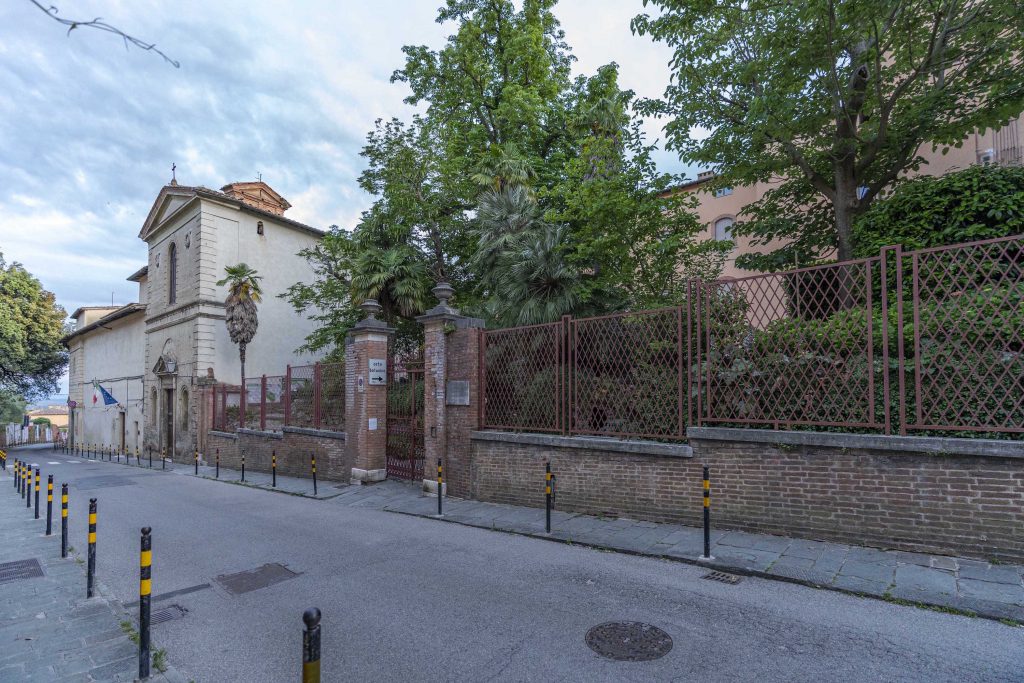 Today over 2000 plant species are preserved here, from the typical Mediterranean and the rarest of the Tuscan environment, to plants for economic use from exotic countries. The flowerbeds with ornamental plants, pergolas and rows of trees form the original section, set up according to the canons of nineteenth-century gardens. In the remaining area towards the valley there is a farm, dedicated to the cultivation of fruits and vegetables of Tuscan varieties, interspersed with areas where natural habitats have been reconstructed: the rock garden, the lake and the humid slope. The Herbarium (Herbarium Universitatis Senensis), which includes over 100,000 dried vascular plants, lichens, bryophytes, mushrooms, algae, is housed in special air- conditioned rooms. It is an enchanted little world created by science, passion, curiosity, fantasy. And just the fantasy – the popular one – has generated a legend stating that inside the Botanical Garden there is also a ghost called Momo. Already in the nineteenth century someone had reported inexplicable noises from the garden. Then the ghost had been quiet since the mid-twentieth century, when, afflicted with who knows what neurosis, he began to freak out. One could hear violent blows, creaking steps, repeated splash in the waters of the lake as if someone was diving into it. Small flames flashed in the middle of the foliage. Convincing – one might say – was the testimony of a guy who, passing through Via Mattioli on a rainy night of a storm, noticed a figure in a black cape and a large hat (like the militants of the pious confraternity who, in that same style, accompanied the dead to the cemetery) standing motionless, with his feet lifted off the ground and not even touched by the water that was bursting thick. Shortly thereafter the frightening epiphanies increased, enriching our identikit with other details; on second thought, his indefinite physiognomy which, according to some, resembled him to a gelatinous shadow, like a huge jellyfish. He was even shot with a pistol, yet the bullet did not pass through anything but the tranquility of the night. However, the nights were not at all quiet for the caretaker of the Garden, because the ghost had become nasty and sometimes violent: he pulled the blankets of the bed, turned on the lights, opened doors, moved objects, took delight in nocturnal stone throwing against the glass of the greenhouses or at the address of those who passed in front of the gate. In these circumstances even the watchdog became nervous, constantly moaning and thus creating a climate of anxiety. In short, all those phenomena known as poltergeist were happening. Subject matter enthusiasts began working on the case.
Today over 2000 plant species are preserved here, from the typical Mediterranean and the rarest of the Tuscan environment, to plants for economic use from exotic countries. The flowerbeds with ornamental plants, pergolas and rows of trees form the original section, set up according to the canons of nineteenth-century gardens. In the remaining area towards the valley there is a farm, dedicated to the cultivation of fruits and vegetables of Tuscan varieties, interspersed with areas where natural habitats have been reconstructed: the rock garden, the lake and the humid slope. The Herbarium (Herbarium Universitatis Senensis), which includes over 100,000 dried vascular plants, lichens, bryophytes, mushrooms, algae, is housed in special air- conditioned rooms. It is an enchanted little world created by science, passion, curiosity, fantasy. And just the fantasy – the popular one – has generated a legend stating that inside the Botanical Garden there is also a ghost called Momo. Already in the nineteenth century someone had reported inexplicable noises from the garden. Then the ghost had been quiet since the mid-twentieth century, when, afflicted with who knows what neurosis, he began to freak out. One could hear violent blows, creaking steps, repeated splash in the waters of the lake as if someone was diving into it. Small flames flashed in the middle of the foliage. Convincing – one might say – was the testimony of a guy who, passing through Via Mattioli on a rainy night of a storm, noticed a figure in a black cape and a large hat (like the militants of the pious confraternity who, in that same style, accompanied the dead to the cemetery) standing motionless, with his feet lifted off the ground and not even touched by the water that was bursting thick. Shortly thereafter the frightening epiphanies increased, enriching our identikit with other details; on second thought, his indefinite physiognomy which, according to some, resembled him to a gelatinous shadow, like a huge jellyfish. He was even shot with a pistol, yet the bullet did not pass through anything but the tranquility of the night. However, the nights were not at all quiet for the caretaker of the Garden, because the ghost had become nasty and sometimes violent: he pulled the blankets of the bed, turned on the lights, opened doors, moved objects, took delight in nocturnal stone throwing against the glass of the greenhouses or at the address of those who passed in front of the gate. In these circumstances even the watchdog became nervous, constantly moaning and thus creating a climate of anxiety. In short, all those phenomena known as poltergeist were happening. Subject matter enthusiasts began working on the case. 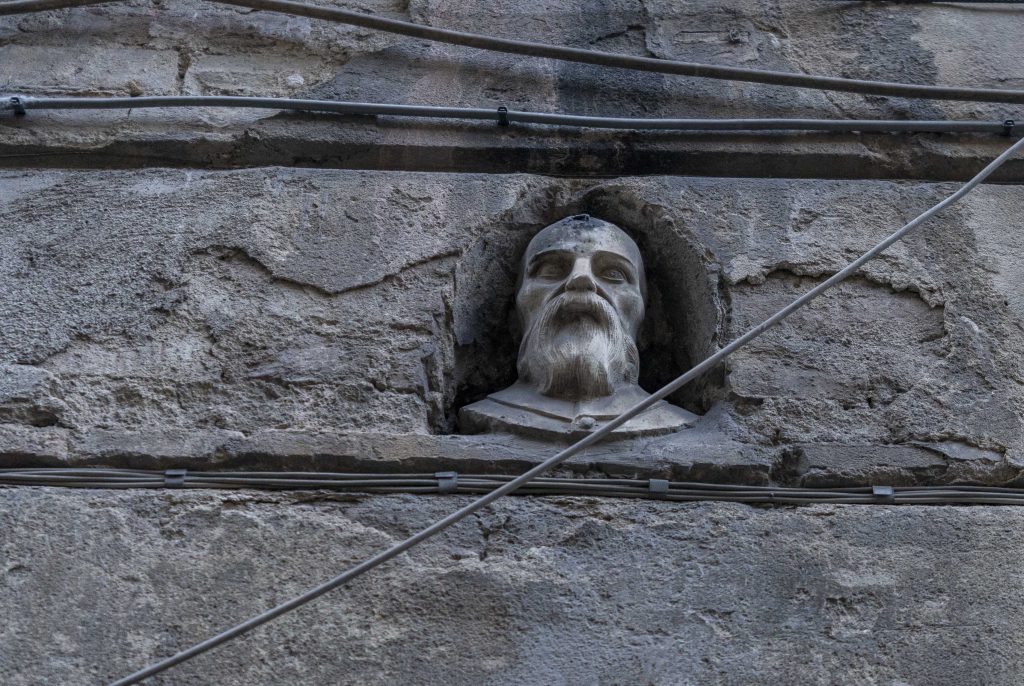 The Sienese Society of Metapsychics summoned a (spiritual) session in the caretaker’s house. The heavy table had decided to shake, and on that occasion the ghost declared his identity: Giacomo, called Momo, a Camaldolese monk devoted to the art of painting, but damned by thears amandi but in sin by having sex with a nun. His remorse had been so great that he had decided to hang himself. Fragmented at the shaky table these words were also understood: “my tomb is down there and my sign is a door”. Someone then remembered the remains of a Romanesque portal incorporated in the new building. Now things were clear, or almost clear. In the course of time, however, the monk’s ‘spontaneous’ declarations would have found different variations. Among the most reliable narrations is the one that he did not want to commit suicide, but – having abandoned the Camaldolese order and become a soldier – died on the battlefield in one of the many clashes between the Sienese and Florentines. It was said that he had been found lying on the banner of the military company of Porta all’Arco. The warlike version immediately followed another. That is, the bodiless inhabitant of the Garden would have been Andrea Ardengheschi, who died in the battle of Montalcino, because he was guilty of having broken a vow made at sant ́ Andrea. Or again: if you really wanted to think of a monk, the story of a Camaldolese who, at the time of Napoleon’s occupation, had buried the treasure of the convent in order to save it from plundering came back to mind. He was killed by the soldiers so as not to reveal where the precious grave was; and on which, even when he was dead, he continued to keep guard. Needless to say, that the story of greater popular belief has always been the story of the monk-lover- suicide. Someone has managed to give him a face by portraying him in a wall-mounted bust on a house in the nearby Via della Cerchia, marked today by the number 50. He has a fluffy beard and a sort of cassock. But in that case – the contradictory debate arises again – it would not be the habit that would characterize that monk because it could also be the hermit who always lived there; or, according to expert hagiographers, the most tranquilizing image of St. Philip Neri.
The Sienese Society of Metapsychics summoned a (spiritual) session in the caretaker’s house. The heavy table had decided to shake, and on that occasion the ghost declared his identity: Giacomo, called Momo, a Camaldolese monk devoted to the art of painting, but damned by thears amandi but in sin by having sex with a nun. His remorse had been so great that he had decided to hang himself. Fragmented at the shaky table these words were also understood: “my tomb is down there and my sign is a door”. Someone then remembered the remains of a Romanesque portal incorporated in the new building. Now things were clear, or almost clear. In the course of time, however, the monk’s ‘spontaneous’ declarations would have found different variations. Among the most reliable narrations is the one that he did not want to commit suicide, but – having abandoned the Camaldolese order and become a soldier – died on the battlefield in one of the many clashes between the Sienese and Florentines. It was said that he had been found lying on the banner of the military company of Porta all’Arco. The warlike version immediately followed another. That is, the bodiless inhabitant of the Garden would have been Andrea Ardengheschi, who died in the battle of Montalcino, because he was guilty of having broken a vow made at sant ́ Andrea. Or again: if you really wanted to think of a monk, the story of a Camaldolese who, at the time of Napoleon’s occupation, had buried the treasure of the convent in order to save it from plundering came back to mind. He was killed by the soldiers so as not to reveal where the precious grave was; and on which, even when he was dead, he continued to keep guard. Needless to say, that the story of greater popular belief has always been the story of the monk-lover- suicide. Someone has managed to give him a face by portraying him in a wall-mounted bust on a house in the nearby Via della Cerchia, marked today by the number 50. He has a fluffy beard and a sort of cassock. But in that case – the contradictory debate arises again – it would not be the habit that would characterize that monk because it could also be the hermit who always lived there; or, according to expert hagiographers, the most tranquilizing image of St. Philip Neri.
This is where the flow of legends stops. Nothing else has been recorded in the following decades that soon reached the new millennium, where – unfortunately – even ghosts are no longer what they used to be.
Produced by: toscanalibri.it
Texts edited by: Luigi Oliveto
Editorial coordination: Elisa Boniello e Laura Modafferi
Photos: Archivio Comune di Siena
Graphic design: Michela Bracciali
